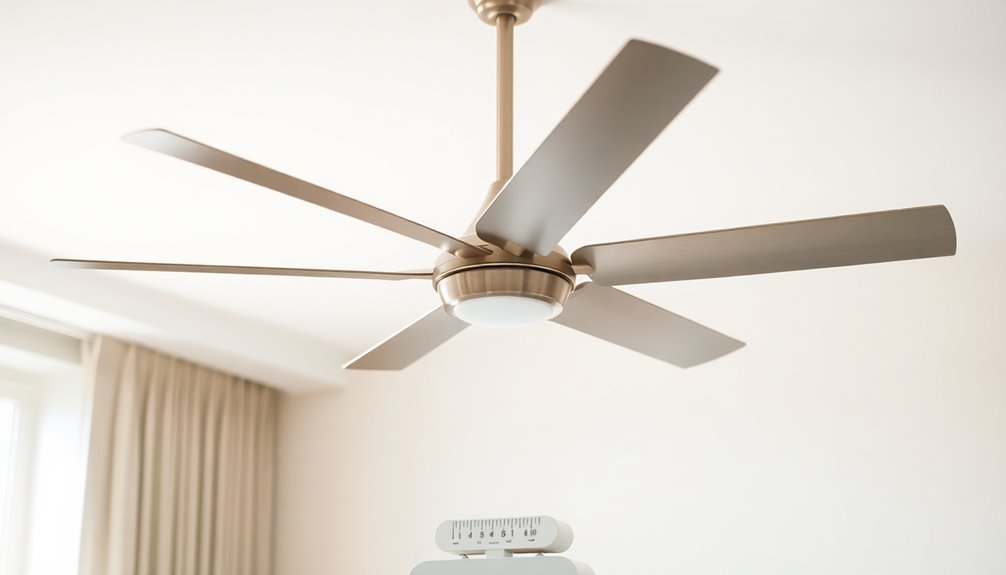A ceiling fan usually weighs between 10 to 50 pounds, with heavy-duty models for commercial use pushing 100 pounds or more. The weight depends on factors like size, material, and design. For instance, plastic fans are lighter than metal ones. Additionally, larger fans tend to weigh more due to increased diameter and components. It's essential to install your fan securely, as standard boxes support up to 70 pounds. Knowing the weight can help optimize installation and efficiency in your space. Keep exploring to uncover more fascinating details about ceiling fans and their features!
Key Takeaways
- Average ceiling fans weigh between 10 to 50 pounds, with heavier models suitable for larger spaces and commercial use.
- Lightweight ceiling fans typically weigh around 10-20 pounds, while heavy-duty fans can exceed 50 pounds.
- Fan weight is affected by materials used; plastic fans are lighter, while metal and wooden fans are generally heavier.
- Standard ceiling fan support boxes can hold 35 to 70 pounds, with specialized boxes accommodating up to 200 pounds.
- Proper installation is crucial; secure mounting to ceiling joists is essential to safely support the fan's weight.
Weight Range of Ceiling Fans

Ceiling fans typically weigh between 10 to 50 pounds for residential models, while industrial and commercial fans can range from 100 to 400 pounds.
The weight of a ceiling fan depends on factors like size, material, and motor type. Most residential fans are made from plastic, metal, or wood, contributing to their lighter weight.
When installing your fan, remember that standard ceiling fan boxes can support 50 to 70 pounds, while specialized ones can handle 150 to 200 pounds. It is important to note that ceiling fan weight is not rated for carrying additional loads beyond its own weight.
Always verify your fan is mounted securely to a ceiling joist using wood screws and a UL-rated electrical box.
Avoid hanging heavy objects from your fan, but lightweight decorations like paper products are generally safe.
Size Considerations for Fans

When choosing the right fan for your space, it's essential to take into account the size of the room and ceiling height.
Start by measuring your room's length and width to calculate the square footage. Use guidelines to match the appropriate blade span to your room size—rooms under 90 sq. ft. need blades between 15" and 42".
Next, guarantee you maintain a minimum clearance of 7 feet from the floor to the fan blades. If you have high ceilings, consider using downrods to achieve the right height. Proper sizing ensures efficient air circulation in your space, which is crucial for comfort and energy savings.
Finally, remember that larger rooms require fans with longer blades to circulate air effectively. Selecting the right size will enhance comfort and efficiency in your space.
Material Impact on Weight

Choosing the right size fan is only part of the equation; the materials used in its construction also play an essential role in its overall weight. If you opt for a fan with plastic components, you'll find it's lighter, making it easier to handle, especially in outdoor models designed for water resistance. In contrast, metal fans are heavier and often used in commercial settings or lighted models. The blade material matters too; plastic blades are lighter than wood or steel blades, which can greatly increase weight. Additionally, fan-only models are typically lighter than those with lights due to the extra fixtures. Finally, outdoor fans are built sturdier, causing them to weigh more than their indoor counterparts. Notably, larger diameter fans generally weigh more, further influencing your choice.
Installation Requirements

Before you start the installation process, it's crucial to take into account several factors that will affect the performance and safety of your ceiling fan.
First, choose the right location: keep at least 18 inches from walls, maintain a minimum of 7 feet from the floor, and center the fan in the room. If you have a sloped ceiling, use a special mounting kit.
When mounting the fan, secure the bracket to a fan-rated electrical box and connect the wires correctly. Always turn off the power at the breaker box and use a voltage tester for safety. Standard fans commonly have blade spans of 29–56 inches, which is important to consider for the size of your room.
Having a second person to help hold the fan is a good idea. Finally, follow the manufacturer's instructions for a successful installation.
Weight Capacity of Fixtures

Understanding the weight capacity of fixtures is essential for ensuring a safe and effective ceiling fan installation. Ceiling fan boxes typically support between 35 to 70 pounds for fans and 50 to 90 pounds for fixtures. For heavier installations, consider using L-shaped brackets or bar brackets, which can hold up to 150-200 pounds. Always choose the right box: for example, TP261 supports 35 pounds for fans, while TP301 and TP275 can handle 70 pounds.
Additionally, it's important to note that standard ceiling fan weight ranges from 10 to 50 lbs, which helps in selecting the appropriate mounting hardware. Regular maintenance, such as checking for loose components, is crucial to ensure the fan remains securely attached and operates safely. Securely attach the box to at least one ceiling joist using wood screws—drywall screws won't cut it. Before installation, verify the box's stability; it shouldn't move when tugged.
Surprising Facts About Fans

The weight capacity of your ceiling fan fixture isn't the only important factor to contemplate; there are some surprising facts about ceiling fans that might change how you view them.
For instance, while they help circulate air, ceiling fans also produce heat due to their motors, so the room temperature doesn't drop considerably. Additionally, larger blades are more effective in enhancing air movement, making them better for cooling larger spaces.
Plus, a good fan should have over 100 cubic feet per minute per watt, but running it at higher speeds can waste energy without improving comfort.
Curiously, you can even reverse the fan direction in winter to distribute warmth evenly.
Finally, the fan's weight and materials impact installation requirements, highlighting the need for reinforced brackets for heavier models.
Energy Efficiency and Fan Weight

While it's easy to overlook, the weight of your ceiling fan plays a significant role in its energy efficiency. Heavier fans typically use sturdier materials and feature better designs that can enhance airflow. This means you can enjoy increased efficiency, especially with larger fans that maximize airflow per watt. The Ceiling Fan Energy Index (CFEI) now offers a clearer measure of efficiency, requiring fans to meet specific standards at various speeds. Fans equipped with DC motors or rubber flywheels tend to be quieter and more efficient, too. Additionally, CFEI compliance necessitates a minimum efficiency of 1.00 at high speed, which encourages the production of higher-performing fans. When selecting a ceiling fan, consider not just the weight but also how its design affects performance and energy savings in your space.
Optimal Fan Placement Tips

To achieve ideal airflow and comfort in your space, placing your ceiling fan correctly is essential.
Start by centering the fan in the room for balanced airflow, especially in larger or oddly shaped spaces. Make sure there's at least 7 feet from the floor to the fan blades, aiming for a height of 8 to 9 feet for maximum circulation. Additionally, consider using multiple fans in larger rooms to ensure effective air coverage. The use of best home security systems can also enhance your overall home comfort and safety while you enjoy the airflow from your fan.
Keep the fan blades at least 18 inches away from walls or obstacles to prevent airflow disruption. If your ceiling is higher than 9 feet, use a downrod; for lower ceilings, opt for a flush-mounted fan.
Always consider the ceiling type and room layout to maintain both efficiency and aesthetics in your design.
Frequently Asked Questions
Do Ceiling Fans Come With a Warranty Regarding Weight Issues?
Yes, ceiling fans typically come with warranties that address weight-related issues.
For instance, if your fan wobbles due to mixing blades of different weights, it's not covered under the warranty. However, if there's a manufacturing defect related to weight, you can seek service under the warranty.
Just remember, installation faults or improper mounting won't be covered, so guarantee everything's set up correctly to avoid potential issues.
Can I Use a Ceiling Fan Outdoors Safely?
You can use a ceiling fan outdoors safely, but you need to choose the right type.
Look for UL Damp or UL Wet-rated fans, as they're designed to handle moisture and direct exposure to the elements.
Install it properly, using weatherproof connections and GFCI protection to prevent electrical hazards.
Regular inspections and cleaning guarantee it stays in good condition.
Always prioritize safety by following local codes and guidelines for outdoor installations.
How Do I Maintain the Weight of My Ceiling Fan?
To maintain your ceiling fan's weight, guarantee it's securely mounted and check for any loose connections regularly.
Tighten screws to prevent wobbling, which can affect balance. Clean the blades and motor housing frequently to avoid dust buildup, as that can impact performance.
Lubricate moving parts according to the manufacturer's instructions to guarantee smooth operation.
Finally, balance the blades using a balancing kit if you notice any shaking or noise during operation.
Are Heavier Ceiling Fans More Durable Than Lighter Ones?
You might think heavier ceiling fans are more durable, but that's not always true. The added weight can strain the housing and gear assembly, leading to more frequent repairs.
Plus, heavier fans can burden your ceiling's structural integrity, posing safety risks. While they may provide better airflow, they often consume more energy and increase operational costs.
Ultimately, durability depends more on design and materials than just weight alone.
Can I Install a Ceiling Fan on a Sloped Ceiling?
Yes, you can install a ceiling fan on a sloped ceiling! Many fans are designed to work with angles up to 45 degrees, but you might need an adapter for steeper slopes.
First, measure the rise and run of your ceiling to determine the angle. Choose a longer downrod for safe installation, ensuring the fan blades are at least 7 feet above the floor.
Don't forget to consult the manufacturer's guidelines for compatibility!
Conclusion
In summary, knowing how much a ceiling fan weighs can help you make informed decisions about installation and placement. Remember to take into account size, material, and fixture capacity to guarantee safety and peak performance. Don't overlook the energy efficiency benefits that come with the right fan choice. With these surprising facts in mind, you can confidently enhance your space and enjoy the comfort of a well-placed ceiling fan. Happy cooling!









